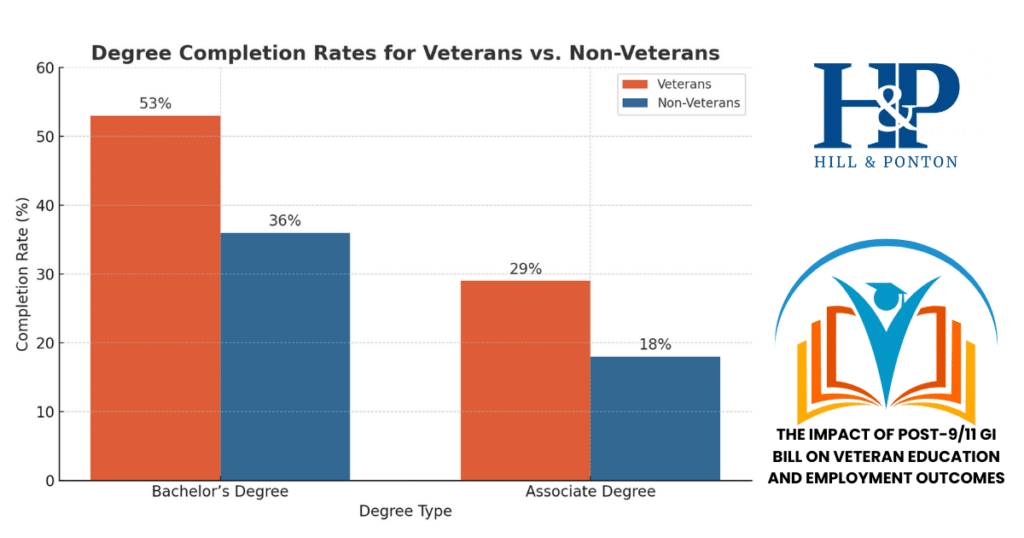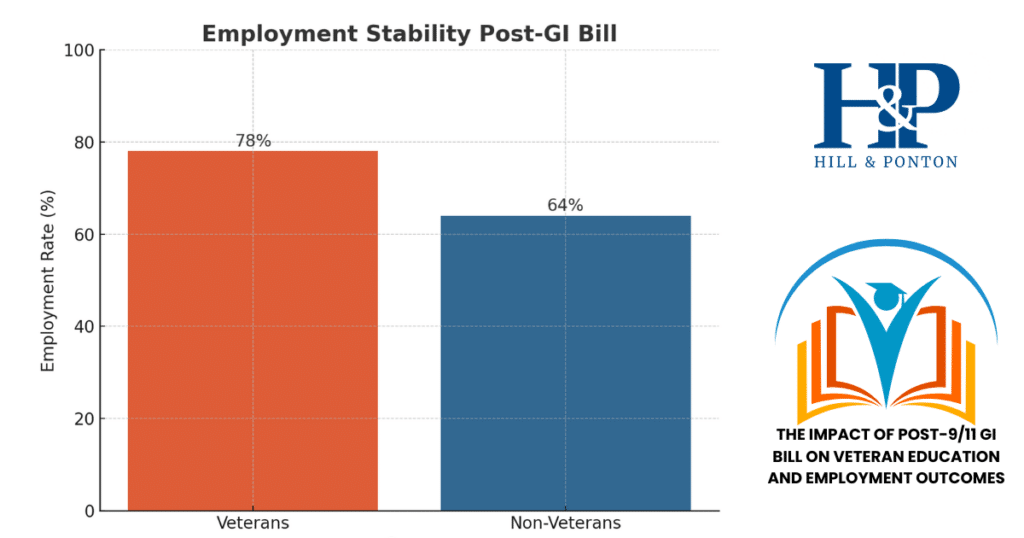“With the signing of this bill, a well-rounded program of special veterans’ benefits is nearly completed. It gives emphatic notice to the men and women in our armed forces that the American people do not intend to let them down.”
President Franklin D. Roosevelt, 1944
The Post-9/11 GI Bill continues to uphold the promise made by President Roosevelt when he signed the original GI Bill into law in 1944. This landmark legislation was designed to support veterans as they transitioned back to civilian life, and its legacy lives on in the opportunities provided by the Post-9/11 GI Bill.
This article explores the significant impact of the Post-9/11 GI Bill on veterans’ education and employment outcomes, from increased college enrollment to long-term career success. We’ll break down how this legislation has shaped the lives of veterans and discuss the financial benefits, challenges, and policy recommendations that can help maximize its potential.
Here’s what you can expect to learn:
- Increased Enrollment and Degree Completion: Discover how the Post-9/11 GI Bill has led to higher enrollment and graduation rates among veterans, particularly in public and non-profit institutions.
- Improved Earnings and Job Stability: Understand how veterans using the GI Bill experience increased earnings and job stability, with younger veterans and those holding advanced degrees seeing the greatest benefits.
- Financial Benefits and Tax Implications: Learn about the shift from the Montgomery GI Bill (MGIB) to the Post-9/11 GI Bill, which has boosted the utilization of education tax credits and increased veterans’ lifetime earnings.
- Overcoming Challenges: Explore the unique challenges veterans face in civilian academic settings, including mental health concerns, and discover strategies for success through support and planning.
- Policy Recommendations: Get insights into how to improve the GI Bill’s effectiveness, including recommendations for better funding for veteran support centers, promoting high-ROI programs, and increasing flexibility for part-time students.
Whether you’re a veteran, policy-maker, or someone interested in veteran affairs, this article offers valuable insights into how the Post-9/11 GI Bill continues to shape the futures of those who have served.
The GI Bill: A Lifeline for Veterans
The GI Bill has been a cornerstone of support for American veterans since its inception with the Servicemen’s Readjustment Act of 1944. Originally designed to provide World War II veterans with resources for education, employment, and homeownership, it played a crucial role in helping millions reintegrate into civilian life and significantly shaped post-war America.
Over the years, the GI Bill has evolved to meet the changing needs of veterans. In 1984, the Montgomery GI Bill was introduced, extending educational benefits to post-Vietnam veterans. Although less transformative than the original, it laid the groundwork for the more comprehensive and impactful Post-9/11 GI Bill.
The Post-9/11 GI Bill: Empowering a New Generation of Veterans
The Post-9/11 GI Bill, one of the most robust educational support programs for veterans, is tailored specifically for those who served on active duty after September 10, 2001. This bill provides a wide array of benefits aimed at helping veterans and their families pursue higher education and vocational training, thereby empowering them to build successful post-service careers.
Key benefits of the Post-9/11 GI Bill include:
- Tuition Coverage: The bill covers up to 100% of tuition and fees for in-state students at public institutions, ensuring that veterans can pursue their education without the burden of overwhelming debt.
- Housing Allowance: A monthly housing allowance is provided to assist with living expenses, making it easier for veterans to focus on their studies without financial strain.
- Book Stipend: An annual stipend is available to cover the cost of books and supplies, ensuring that veterans have the resources they need to succeed in their educational pursuits.
Beyond traditional college education, the Post-9/11 GI Bill also supports vocational training, apprenticeships, and on-the-job training programs. This flexibility allows veterans to choose the path that best suits their skills and career goals, whether in academia or the trades.
The Post-9/11 GI Bill stands as a testament to the nation’s commitment to honoring the service of veterans by providing them with the tools and opportunities to succeed in civilian life.
For a more comprehensive understanding of the historical impact and specific provisions of the Post-9/11 GI Bill, you can explore the U.S. Department of Defense’s detailed overview: “75 Years of the GI Bill: How Transformative It’s Been.”
Education Outcomes for Veterans
The Post-9/11 GI Bill has profoundly transformed the educational landscape for veterans, leading to significant increases in both college enrollment and degree completion rates. By providing robust financial support and resources, the GI Bill has made higher education more accessible and achievable for those who have served in the military. Let’s take a closer look at how these benefits have impacted veterans’ education, backed by compelling statistics.
Boosting College Enrollment

One of the most remarkable impacts of the Post-9/11 GI Bill is the substantial increase in college enrollment among veterans. Research conducted by the American Institutes for Research (AIR) highlights that veterans utilizing the GI Bill are enrolling in higher education institutions at a much higher rate compared to their non-veteran peers. Specifically, 62% of veterans using the Post-9/11 GI Bill have enrolled in college, in contrast to just 37% of non-veterans. This significant difference underscores the crucial role the GI Bill plays in motivating veterans to pursue higher education and enhance their career opportunities.
Enrollment Across Different Institutions
Veterans’ enrollment preferences also reveal important trends across various types of educational institutions:
- Public Universities: Attracting 45% of veterans, public universities are the most popular choice, likely due to the comprehensive financial benefits, including full tuition coverage for in-state students.
- Community Colleges: Approximately 35% of veterans choose community colleges, likely due to their affordability, flexibility, and the opportunity to earn credits that can be transferred to four-year institutions.
- Private Non-Profit Institutions: About 15% of veterans enroll in private non-profit institutions, which often offer specialized programs and smaller class sizes for a more tailored educational experience.
- For-Profit Institutions: Only 5% of veterans opt for for-profit institutions, likely due to concerns about the quality of education and the return on investment compared to other types of institutions.
Degree Completion Success
53% of veterans using the Post-9/11 GI Bill complete their bachelor’s degrees within six years, compared to just 36% of non-veterans.
American Institutes for Research (AIR)
Enrollment is only part of the story—the Post-9/11 GI Bill has also led to higher degree completion rates among veterans, which is vital for their long-term career and financial stability. According to the AIR study:
- Bachelor’s Degrees: 53% of veterans using the Post-9/11 GI Bill complete their bachelor’s degrees within six years, compared to just 36% of non-veterans. This significant difference highlights the effectiveness of the GI Bill in supporting veterans through to graduation.
- Associate Degrees: For associate degrees, 29% of veterans complete their programs within three years, compared to 18% of non-veterans. These completion rates demonstrate the GI Bill’s role in enabling veterans to achieve their educational goals within a reasonable timeframe.

Demographic Influences on Completion Rates
While these statistics are promising, it’s important to acknowledge that degree completion rates vary across different demographic groups. Factors such as age, race, and gender can influence outcomes. For instance, older veterans and those from minority backgrounds often face unique challenges, including balancing education with work and family responsibilities. Despite these challenges, many of these veterans demonstrate remarkable resilience and determination in pursuing their educational goals.
Persistence in Education
Veterans are known for their persistence, and this trait is evident in their educational journeys. The Post-9/11 GI Bill provides the support necessary for veterans to stay the course and complete their degrees, even when faced with challenges.
On average, veterans utilize 36 months of their GI Bill benefits to complete their degrees, which represents the full entitlement period for many. This statistic reflects the determination of veterans to make the most of the educational opportunities available to them.
Factors Contributing to Persistence
Several key factors contribute to the persistence and success of veterans in higher education:
- Support Services: Access to veteran-specific support services on campus, such as academic advising, counseling, and career planning, plays a crucial role in helping veterans navigate the challenges of higher education.
- Financial Aid: The financial security provided by the GI Bill allows veterans to focus on their studies without the added stress of financial strain.
- Personal Determination: Ultimately, the personal determination and discipline instilled in veterans during their military service drive many to overcome obstacles and achieve their academic goals.
Employment Outcomes Post-GI Bill
The Post-9/11 GI Bill has not only enabled veterans to achieve their educational goals but has also had a significant impact on their employment outcomes. By examining changes in earnings, job stability, and labor market experiences, we can gain a clearer understanding of how this legislation has shaped veterans’ careers and overall economic well-being.
Earnings and Job Stability
Veterans who utilized the GI Bill saw a notable increase in their annual earnings, amounting to an average of $5,000 more per year nine years after separating from military service.
National Bureau of Economic Research (NBER)
One of the most significant benefits of the Post-9/11 GI Bill is its positive impact on veterans’ long-term earnings and job stability. Research conducted by the National Bureau of Economic Research (NBER) demonstrates that veterans who utilized the GI Bill saw a notable increase in their annual earnings. Specifically, these veterans experienced a 10% increase in earnings compared to those who did not use the benefits, amounting to an average of $5,000 more per year nine years after separating from military service. This boost in income underscores the economic value of the GI Bill in helping veterans secure better-paying jobs and achieve financial stability.

Additionally, employment stability among veterans using the GI Bill is markedly higher. A study by the American Institutes for Research (AIR) found that 78% of veterans who utilized the Post-9/11 GI Bill were employed within two years of completing their education, compared to just 64% of non-veterans. This higher employment rate highlights the effectiveness of the GI Bill in not only facilitating educational attainment but also in enhancing veterans’ competitiveness in the job market.
Navigating the Labor Market
While the Post-9/11 GI Bill provides significant advantages, veterans often face unique challenges in the labor market, particularly due to the time spent in military service, which can result in lost civilian work experience. This gap can pose difficulties during the initial job search and in career advancement. However, the educational benefits offered by the GI Bill play a crucial role in mitigating these challenges by equipping veterans with the skills and credentials needed to succeed in the civilian workforce.
The GI Bill helps veterans navigate these challenges by:
- Providing opportunities for further education and training, enhancing their qualifications.
- Bridging the gap between military and civilian careers, allowing for a smoother transition.
- Equipping veterans with skills and credentials that make them more attractive to employers.
Veterans who may have missed out on valuable civilian labor market experience during their service can use the GI Bill to pursue further education and training, thereby enhancing their qualifications and making them more attractive to employers. This helps bridge the gap between military and civilian careers, allowing veterans to transition more smoothly into the workforce.
Demographic Differences
Employment outcomes among veterans vary significantly across different demographic groups. Younger veterans, particularly those between the ages of 25 and 34, tend to see the most substantial benefits from the Post-9/11 GI Bill in terms of both earnings and job stability. Additionally, veterans with higher levels of education also experience greater economic gains, underscoring the importance of advanced degrees in the modern labor market.
Veterans from minority backgrounds also benefit from the GI Bill, although disparities in employment rates and earnings persist. These findings suggest that while the GI Bill is a powerful tool for improving employment outcomes, targeted support and initiatives may still be necessary to address the unique challenges faced by certain demographic groups within the veteran community.
Financial Implications and Tax Benefits
The financial support provided by the Post-9/11 GI Bill extends well beyond covering tuition and housing. Veterans can also leverage various tax benefits and financial incentives that further enhance their economic well-being. Understanding these financial implications is key to maximizing the benefits of the GI Bill and reducing financial stress.
Leveraging Education Tax Benefits
Veterans utilizing the Post-9/11 GI Bill have access to several education-related tax benefits that can significantly offset the cost of their education and improve their overall financial health. The transition from the Montgomery GI Bill (MGIB) to the Post-9/11 GI Bill has opened the door for more veterans to take advantage of education tax credits. According to Veterans Education Success (VES), this shift has led to an increase in the use of tax benefits such as the Lifetime Learning Credit (LLC) and the American Opportunity Tax Credit (AOTC).
The VES report reveals that veterans using the Post-9/11 GI Bill are more likely to claim these education tax credits, with 40% of veterans reporting that they claimed the AOTC, compared to just 25% of those not using GI Bill benefits. This increased utilization of tax credits underscores the importance of understanding and applying these benefits to maximize the financial support available to veterans.
Balancing Costs and Benefits
While the Post-9/11 GI Bill offers substantial financial support, it’s essential for veterans to understand the balance between the costs and benefits associated with their education choices. Research from the American Institutes for Research (AIR) indicates that veterans using the Post-9/11 GI Bill often see a significant return on investment (ROI) from their education. On average, veterans experience a 15% increase in lifetime earnings, translating to an additional $300,000 over their careers. However, the ROI varies depending on the type of institution and degree program chosen.
Key Financial Considerations:
- Public Institutions: Veterans attending public universities typically see the highest financial returns, benefiting from lower out-of-pocket costs and higher post-graduation earnings.
- For-Profit Institutions: In contrast, veterans attending for-profit institutions often encounter higher education costs and lower ROI, making it crucial to weigh the financial implications of such choices carefully.
By understanding these financial dynamics, veterans can make informed decisions about their education, ensuring they maximize the benefits of the Post-9/11 GI Bill while minimizing potential financial burdens.
Overcoming Challenges in Education and Employment
While the Post-9/11 GI Bill offers substantial support for veterans, many still face obstacles on their educational and career journeys. Understanding these challenges and knowing how to overcome them can help veterans fully maximize the benefits of the GI Bill and achieve their goals.
Common Hurdles in Higher Education
Veterans often encounter unique difficulties when transitioning from military to academic life. Recognizing and addressing these hurdles is crucial for a smoother and more successful educational experience.
- Adjustment to Civilian Academic Life: Transitioning from a highly structured military environment to the more flexible setting of academia can be disorienting. Veterans may struggle with establishing a new routine and integrating into a predominantly younger student body, which can affect their sense of belonging and academic performance.
- Mental Health Issues: Many veterans face significant mental health challenges such as PTSD, anxiety, and depression, which can hinder their academic success. According to Veterans Education Success (VES), about 30% of veterans report that these mental health issues adversely impact their studies.
- Financial Pressures: Although the GI Bill provides financial support, some veterans still experience financial stress due to living expenses and additional educational costs that are not fully covered by their benefits. This financial strain can be especially difficult for veterans who have families to support.
Strategies for Overcoming These Obstacles
Veterans can employ several effective strategies to overcome these challenges and make the most of their educational opportunities:
- Utilize Campus Resources: Many universities offer dedicated veteran support centers that provide counseling, academic advising, and peer support groups. Engaging with these resources can offer veterans the support and sense of community they need to succeed.
- Seek Mental Health Support: Accessing mental health services through the VA or on-campus resources can help veterans manage PTSD, anxiety, and depression. Regular counseling and therapy can lead to significant improvements in both academic performance and overall well-being.
- Financial Planning: Developing a detailed budget and seeking additional financial aid or scholarships can ease financial stress. Many institutions offer veteran-specific scholarships and emergency funds to help cover unexpected expenses, ensuring that veterans can focus more on their studies and less on financial concerns.
Maximizing the GI Bill’s Potential

To fully leverage the benefits of the Post-9/11 GI Bill, veterans should consider the following strategies:
- Plan Your Education Path: Carefully choose institutions and programs that align with your long-term career goals. Public and non-profit institutions often provide a better return on investment (ROI) compared to for-profit schools, making them a wiser choice for many veterans.
- Take Full Advantage of Benefits: Ensure you’re utilizing all the financial support the GI Bill offers, including housing allowances, book stipends, and other available benefits. These resources can significantly reduce out-of-pocket expenses and make your educational journey more affordable.
- Network and Build Relationships: Actively engage with faculty, join student organizations, and participate in internships. Networking can open doors to job opportunities and help you build valuable connections that will benefit your career after graduation.
Looking Ahead: Policy Implications
The GI Bill has successfully increased college enrollment and degree completion rates among veterans, which in turn has led to improved long-term earnings and greater job stability.
Veterans Education Success (VES)
As we reflect on the impact of the Post-9/11 GI Bill, it’s essential to consider the broader policy implications and explore potential improvements that could further enhance educational and employment outcomes for veterans. By critically evaluating current policies and making informed recommendations, we can ensure that future veterans receive the support they need to thrive.
Evaluating Current Policies
The Post-9/11 GI Bill has brought about significant benefits for veterans, but there are both positive and negative aspects to consider.
Key Impacts and Findings:
- Positive Outcomes: The GI Bill has successfully increased college enrollment and degree completion rates among veterans, which in turn has led to improved long-term earnings and greater job stability. These positive outcomes highlight the Bill’s effectiveness in supporting veterans as they transition into civilian careers.
- Challenges: Despite these successes, some veterans still face challenges, particularly related to high student loan debt. This issue is especially prevalent among those who attend for-profit institutions, where returns on investment are often mixed. According to Veterans Education Success (VES), these schools sometimes offer less favorable outcomes, underscoring the need for better guidance and support in educational decision-making.
Recommendations for Improvement
To further strengthen the effectiveness of the Post-9/11 GI Bill, several policy recommendations can be considered:
- Increase Funding for Veteran Support Centers: By providing more resources for counseling, academic advising, and mental health services, we can help veterans transition more smoothly into academic life and overcome the unique challenges they face.
- Strengthen Financial Planning Resources: Offering financial literacy programs and personalized financial advising can empower veterans to manage their benefits more effectively, reducing financial stress and improving their overall educational experience.
- Promote Higher ROI Programs: Encourage veterans to enroll in public and non-profit institutions that typically offer better returns on investment. Providing clear and accessible information about the long-term financial outcomes of various programs can help veterans make more informed decisions about their education.
- Monitor and Regulate For-Profit Institutions: Implement stricter regulations and oversight for for-profit schools to ensure they provide genuine value and do not exploit veteran benefits. This step is crucial to protect veterans from making costly educational choices that may not yield the desired outcomes.
- Extend GI Bill Benefits: Consider extending the duration of GI Bill benefits to accommodate veterans who may require more time to complete their education due to health issues or other personal challenges. This extension would provide additional support for those who need it most.
- Incorporate Flexibility for Part-Time Students: Adjust the benefits structure to better support part-time students, who often balance their education with work or family responsibilities. This flexibility would ensure that all veterans can access the educational opportunities they deserve, regardless of their circumstances.
In honoring the legacy of the GI Bill, we continue to uphold the enduring promise made by President Roosevelt to support our veterans. As Roosevelt emphasized, the GI Bill was designed to ensure that the American people “do not intend to let them down.” This commitment remains as vital today as it was then, guiding our ongoing efforts to enhance the educational and employment outcomes for those who have served our country.
References
- Accenture Federal Services. (2021). GI Bill Education Benefits Utilization. Retrieved from https://www.accenture.com/us-en/blogs/federal-viewpoints/gi-bill-education-benefits-utilization
- American Institutes for Research. (2024). First Look: Post-9/11 GI Bill Outcomes for Enlisted Veterans. Retrieved from https://www.air.org/sites/default/files/2024-02/First-Look-Post-9-11-GI-Bill-Outcomes-Enlisted-Veterans-February-2024.pdf
- American Institutes for Research. (2024). Post-9/11 GI Bill Outcomes at Public Flagship Universities in the Great Lakes Region. Retrieved from https://www.air.org/sites/default/files/2024-07/pgib-outcomes-public-flagship-great-lakes.pdf
- American Institutes for Research. (2024). Post-9/11 GI Bill Outcomes by Use and Enrollment Characteristics. Retrieved from https://www.air.org/sites/default/files/2024-07/pgib-outcomes-by-use-enrollment-characteristics.pdf
- National Bureau of Economic Research. (2021). You Can’t Handle The Truth: The Effects Of The Post-9/11 GI Bill On Higher Education And Earnings. Retrieved from http://www.nber.org/papers/w29024
- U.S. Department of Defense. (2019). 75 Years of the GI Bill: How Transformative It’s Been. Retrieved from https://www.defense.gov/News/Feature-Stories/Story/article/1727086/75-years-of-the-gi-bill-how-transformative-its-been/
- Veterans Education Success. Annual and Cumulative Student Loan Debt Among Veterans Using and Not Using GI Bill Benefits. Retrieved from https://vetsedsuccess.org/annual-and-cumulative-student-loan-debt-among-veterans-using-and-not-using-gi-bill-benefits/
- Veterans Education Success. Weak Return on Investment at Trade Schools That Enroll GI Bill Beneficiaries. Retrieved from https://vetsedsuccess.org/weak-return-on-investment-at-trade-schools-that-enroll-gi-bill-beneficiaries/




